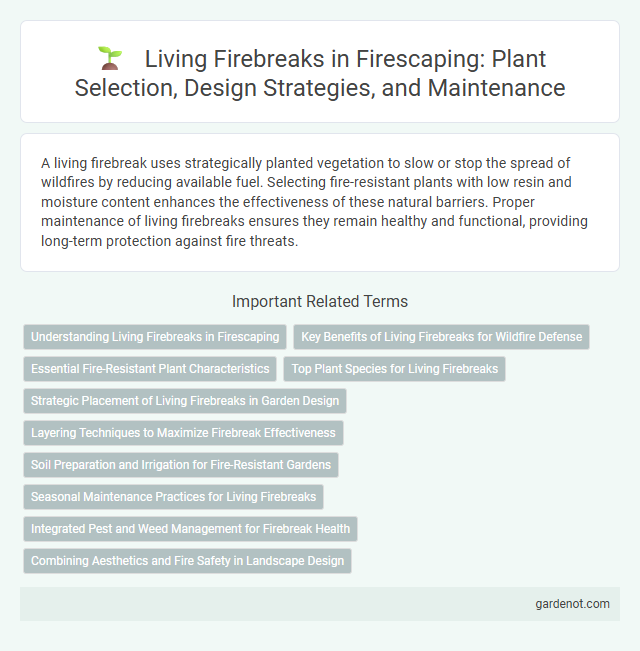A living firebreak uses strategically planted vegetation to slow or stop the spread of wildfires by reducing available fuel. Selecting fire-resistant plants with low resin and moisture content enhances the effectiveness of these natural barriers. Proper maintenance of living firebreaks ensures they remain healthy and functional, providing long-term protection against fire threats.
Understanding Living Firebreaks in Firescaping
Living firebreaks in firescaping involve strategically planting fire-resistant vegetation to reduce wildfire spread by creating natural barriers. These fire-resistant plants slow fire advancement by maintaining higher moisture levels and lower fuel loads compared to surrounding flammable vegetation. Effective living firebreaks combine species such as succulents, hardwoods, and irrigated shrubs to enhance landscape resilience and protect property.
Key Benefits of Living Firebreaks for Wildfire Defense
Living firebreaks create natural barriers that slow wildfire spread by maintaining moisture-rich vegetation and reducing fuel loads. These strategically planted areas enhance landscape resilience, improve ecosystem health, and support biodiversity while protecting properties. Incorporating native, fire-resistant plants in living firebreaks effectively mitigates fire intensity and promotes long-term wildfire defense.
Essential Fire-Resistant Plant Characteristics
Living firebreaks rely on fire-resistant plants with essential characteristics such as high moisture content, low resin or oil levels, and thick, fire-retardant leaves to slow or stop wildfire spread. These plants often have deep root systems to retain hydration and reduce flammability even in dry conditions. Species like succulents, certain deciduous shrubs, and fire-resistant grasses are prime examples used in effective firescaping designs.
Top Plant Species for Living Firebreaks
Top plant species for living firebreaks include fire-resistant native shrubs such as manzanita, ceanothus, and chamise, which have low fuel loads and high moisture content. Succulent ground covers like ice plant and sedum provide effective fire mitigation by retaining water and reducing flammable material accumulation. Strategically planting drought-tolerant trees such as California sycamore and coast live oak enhances firebreak durability while supporting local biodiversity.
Strategic Placement of Living Firebreaks in Garden Design
Strategic placement of living firebreaks in garden design involves situating fire-resistant plants in key locations to interrupt fuel continuity and slow wildfire spread. Incorporating drought-tolerant, low-flammability shrubs such as manzanita or California lilac around property perimeters and near structures enhances protection. Proper spacing and layering of vegetation optimize airflow and reduce fire intensity, creating defensible zones that safeguard landscapes and homes.
Layering Techniques to Maximize Firebreak Effectiveness
Living firebreaks employ layering techniques by integrating multiple vegetation types with varying moisture content and flammability to disrupt fire spread effectively. Strategically planting drought-resistant shrubs, fire-retardant ground covers, and deciduous trees creates a multi-layer barrier that reduces fuel continuity and intensity. This method enhances firebreak resilience by maximizing moisture retention and minimizing combustible material within the fire-prone landscape.
Soil Preparation and Irrigation for Fire-Resistant Gardens
Effective soil preparation for living firebreaks involves deep tilling and amending soil with organic matter to enhance moisture retention and plant health. Installing drip irrigation systems ensures consistent watering, reducing plant stress and maintaining high moisture levels critical for fire resistance. Properly prepared soil combined with targeted irrigation supports fire-resistant garden plants in creating a living barrier against wildfires.
Seasonal Maintenance Practices for Living Firebreaks
Seasonal maintenance practices for living firebreaks include regular pruning to remove dead or overgrown vegetation, which reduces fuel load and maintains fire resistance. Irrigation scheduling adjusted to seasonal rainfall patterns helps ensure plant health without promoting excessive growth that could become a fire hazard. Monitoring for pest infestations and promptly treating affected areas preserves the firebreak's integrity and long-term effectiveness.
Integrated Pest and Weed Management for Firebreak Health
Living firebreaks utilize integrated pest and weed management strategies to maintain vegetation health and reduce fire risk. Combining biological controls, targeted herbicide application, and regular monitoring minimizes invasive species and supports native biodiversity. Healthy firebreak vegetation enhances fire resistance by limiting fuel buildup and promoting ecosystem resilience.
Combining Aesthetics and Fire Safety in Landscape Design
Living firebreaks integrate fire-resistant plants and strategic spacing to reduce wildfire risk while enhancing landscape beauty. Selecting native, drought-tolerant species with high moisture content creates effective barriers that blend naturally with the environment. This approach balances fire safety regulations with aesthetic appeal, promoting resilient and visually pleasing outdoor spaces.
Living firebreak Infographic

 gardenot.com
gardenot.com